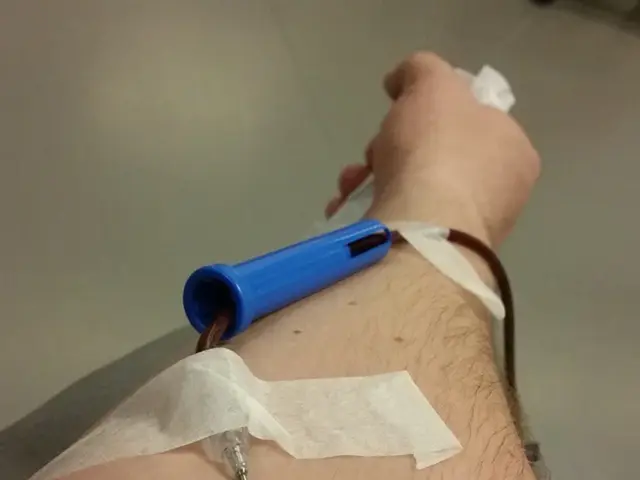Experiencing side effects from nicotine patches? Learn about common symptoms, their duration, and when to seek medical advice.
In the journey to quit smoking, nicotine patches can be a helpful tool for many individuals. These patches, a type of nicotine replacement therapy (NRT), deliver a steady dose of nicotine to help people manage cravings and reduce the physical dependence on cigarettes.
If doctors recommend, an individual may combine nicotine patches with another NRT to relieve periods of intense craving, especially for those who smoke a pack a day or more. Alternative NRT options include gum, nasal spray, lozenges, and inhalers, and the most suitable option may depend on a person's lifestyle and the urgency of their cravings.
However, it's important to note that the use of nicotine patches with certain medications, such as adenosine, cimetidine, and varenicline, may affect the heart rate, cause toxicity, or worsen nicotine-related side effects. Therefore, people should speak with a doctor about any medications they are currently taking before using nicotine patches.
Common side effects of nicotine patches include local skin irritation or rash at the application site, nausea, headache, dizziness, sleep disturbances (such as vivid dreams or insomnia), increased heart rate or blood pressure, and occasionally mood changes.
Effective management strategies for these side effects are available. For instance, rotating the application site daily to different clean, dry, hairless areas on the upper body or upper arm can help alleviate skin irritation. Removing the patch at bedtime if vivid dreams or insomnia occur can reduce sleep disturbances. Nausea, dizziness, and headaches usually improve as the body adjusts, but if persistent or severe, consulting a healthcare provider is advisable.
People with heart conditions or uncontrolled high blood pressure should also consult a healthcare provider before using nicotine patches, as they can increase heart rate and blood pressure. Monitoring symptoms and discussing with a healthcare provider can help adjust therapy if needed.
Individuals can experience symptoms of nicotine withdrawal if their patch dose is too low, including nicotine cravings, insomnia, irritability and frustration, difficulty concentrating, restlessness, depression, increased appetite, anxiety, headaches, fatigue, coughing, dizziness, and mouth ulcers. The right patch dose will depend on how many cigarettes a person smokes per day, and people can speak with a healthcare professional to determine which patch they need.
People will typically reduce the patch strength over time to wean themselves off nicotine. Using nicotine patches for longer periods may be better than returning to smoking. However, it's important to note that long-term use of nicotine patches may not be a long-term replacement for nicotine use but can help wean the body off nicotine dependence.
The National Cancer Institute suggests researching long-term use of NRTs for serious harmful effects. Symptoms of a nicotine overdose include nausea and vomiting, headaches, stomach pain, diarrhea, irregular or fast heart rate, pale skin and mouth, cold sweat, shaking, weakness, confusion or agitation, restlessness, dizziness or faintness, fast breathing, seizures, and should require urgent medical attention. People should not cut the patch or apply heat to the pad or use heat near the pad, as this may increase absorption.
Lastly, people should apply the nicotine patch onto clean, dry, hair-free skin on the upper body, such as the upper chest, shoulder, back, upper or inner arm. People should also dispose of nicotine patches safely to prevent others, children, or animals from coming into contact with them.
In conclusion, nicotine patches can be a valuable tool in the quest to quit smoking. Proper patch placement, adherence to recommended dosage, and consulting a healthcare professional for persistent or severe side effects improve patch tolerability and treatment success.
- For those suffering from degenerative conditions like multiple sclerosis or the skin-related issues of psoriasis and dermatitis, the stress of coping with smoking-induced health-and-wellness problems may exacerbate their mental-health challenges.
- The link between HIV and smoking is complex, but it's known that HIV-positive individuals who smoke are at higher risk for COPD and other health-and-wellness issues, including cardiovascular disease.
- Some forms of atopic disease, such as colitis, are linked to chronic inflammation, and quitting smoking could alleviate this burden, leading to improved health-and-wellness outcomes.
- Hepatitis, a liver disease often caused by viral infections, can be worsened by smoking, which decreases the body's ability to fight off the virus and promotes inflammation.
- Whether it's dry skin or dry eyes related to macular degeneration, smoking can accelerate this degeneration, making it important for people to consider quitting for the sake of their health-and-wellness.
- While smoking can lead to a host of health-and-wellness issues, an underappreciated risk is its impact on the progression of AQ-related conditions, such as the escalation of Crohn's disease to musculoskeletal complications.
- In the world of science, ongoing studies examine the predictive role of smoking in various diseases, underscoring the urgency of addressing this health-and-wellness concern.
- Ghastly health-and-wellness complications, like ulcerative colitis or COPD, can result from years of smoking, emphasizing the need for preventive measures, such as smoking cessation, to safeguard one's health and well-being.
- Science continually advances, offering new prep and treatment options for tackling the twisted web of smoking-related health-and-wellness dilemmas, from nicotine patches to cognitive behavioral therapy for mental-health support.
- Health-and-wellness literature often spotlights the myriad ways smoking affects the body's internal systems, from the heart and lungs to the immune and nervous systems, but less attention is paid to its impact on the skin, such as the appearance of premature wrinkles and poor healing from wounds or ulcers.
- Despite the well-documented harm of smoking to health-and-wellness, it's unfortunate that many individuals begin smoking at young ages, setting themselves up for a lifetime of health-and-wellness challenges, including obesity, which further increases their risk for numerous other diseases.
- Embracing a health-and-wellness lifestyle starts with making tough choices, like quitting smoking and making positive changes in one's life, backed by the support of loved ones, healthcare professionals, and the vast scientific knowledge base available in the quest for improved health outcomes.




